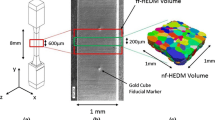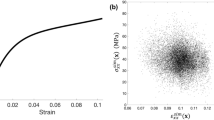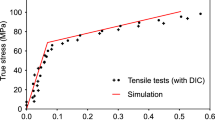Abstract
A three-dimensional dataset of Inconel-625 generated as part of the Air Force Research Laboratory’s Additive Manufacturing Challenge Series is considered to interrogate modeling errors in a crystal-plasticity finite-element (CPFE) framework. Grain-average elastic strains from this framework are compared to measurements made with far-field high-energy X-ray diffraction microscopy (ff-HEDM) on a specimen loaded in tension at room temperature. The ff-HEDM measurements, taken when the specimen was held under load control, were made on the same microstructure considered in the CPFE framework. This one-to-one comparison enables a thorough investigation into modeling discrepancies, specifically those induced by improper boundary condition selection and inability to model stress relaxation events which are a likely characteristic of intermittent plasticity. It is shown that erroneously constraining the Poisson effect locally with kinematic boundary conditions induces over-estimates of off-loading-axis normal strains as far as 100 \(\upmu \)m away from the over-constrained surface, which is roughly 14% of the overall height of the polycrystal in the loading direction. A second set of boundary conditions that relaxes the constraints on the previously over-constrained surface showed clear quantitative improvement in model predictions. Specifically, the errors in the normal components of strains in the off-loading-axes decreased. Further, it was observed that irrespective of which of the two boundary conditions was applied, the CPFE framework deviates considerably from measurements in the plastic regime compared to the elastic regime. This is mainly due to the increased frequency of strain drop (or stress relaxation) events occurring in the plastic regime, most likely caused by shearing of \(\gamma ^{\prime}\) precipitates and other intermittent dislocation activity. The CPFE framework is unable to accommodate the stress relaxation in grains. Nevertheless, the framework is interrogated for its ability to predict such events by comparing predicted slip fields with measured grain-level relaxation events. It is demonstrated that the set of grains experiencing a strain drop (from ff-HEDM measurements) collectively had higher values of plastic strain (calculated from CPFE simulations) compared to the set of grains that did not experience a strain drop.



















Similar content being viewed by others
Notes
The IDs of the 28 challenge grains, taken from the as-supplied 3D microstructure dataset [28], are: 145, 317, 1191, 2489, 2841, 3994, 5876, 6191, 7397, 8445, 11248, 11766, 12334, 12602, 12821, 14655, 15567, 15575, 16504, 16576, 18300, 19092, 19547, 19571, 20330, 21698, 25369, 27757. These IDs will be referred throughout the manuscript.
References
Seifi M, Gorelik M, Waller J, Hrabe N, Shamsaei N, Daniewicz S, Lewandowski JJ (2017) Progress towards metal additive manufacturing standardization to support qualification and certification. J Mater 69:439–455. https://doi.org/10.1007/s11837-017-2265-2
NASA MSFC Technical Standard MSFC-STD-3716(2017) Standard for additively manufactured spaceflight hardware by laser powder bed fusion in metals. Technical report, NASA Marshall Space Flight Center
Fielding J, Davis A, Bouffard B, Kinsella M, Delgado T, Wilczynski J, Marchese K, Wing I (2016) Department of defense additive manufacturing roadmap. Technical Report
Liu X, Furrer D, Kosters J, Holmes J (2018) Vision 2040: a roadmap for integrated, multiscale modeling and simulation of materials and systems, NASA/CR–2018-219771. Technical Report
De Pablo JJ, Jones B, Kovacs CL, Ozolins V, Ramirez AP (2014) The materials genome initiative, the interplay of experiment, theory and computation. Curr Opin Solid State Mater Sci 18(2):99–117. https://doi.org/10.1016/j.cossms.2014.02.003
Lim H, Carroll JD, Battaile CC, Buchheit TE, Boyce BL, Weinberger CR (2014) Grain-scale experimental validation of crystal plasticity finite element simulations of tantalum oligocrystals. Int J Plast 60:1–18. https://doi.org/10.1016/j.ijplas.2014.05.004
Choi YS, Groeber MA, Shade PA, Turner TJ, Schuren JC, Dimiduk DM, Uchic MD, Rollett AD (2014) Crystal plasticity finite element method simulations for a polycrystalline Ni micro-specimen deformed in tension. Metall Mater Trans A 45:6352–6359. https://doi.org/10.1007/s11661-014-2556-y
Zhang T, Collins DM, Dunne FPE, Shollock BA (2014) Crystal plasticity and high-resolution electron backscatter diffraction analysis of full-field polycrystal Ni superalloy strains and rotations under thermal loading. Acta Mater 80:25–38. https://doi.org/10.1016/j.actamat.2014.07.036
Guan Y, Chen B, Zou J, Britton TB, Jiang J, Dunne FP (2017) Crystal plasticity modelling and HR-DIC measurement of slip activation and strain localization in single and oligo-crystal Ni alloys under fatigue. Int J Plast 88:70–88. https://doi.org/10.1016/j.ijplas.2016.10.001
Tari V, Lebensohn RA, Pokharel R, Turner TJ, Shade PA, Bernier JV, Rollett AD (2018) Validation of micro-mechanical FFT-based simulations using high energy diffraction microscopy on Ti-7Al. Acta Mater 154:273–283. https://doi.org/10.1016/j.actamat.2018.05.036
Kapoor K, Sangid MD (2018) Initializing type-2 residual stresses in crystal plasticity finite element simulations utilizing high-energy diffraction microscopy data. Mater Sci Eng A 729(April):53–63. https://doi.org/10.1016/j.msea.2018.05.031
Proudhon H, Guéninchault N, Forest S, Ludwig W (2018) Incipient bulk polycrystal plasticity observed by synchrotron in-situ topotomography. Materials 11:1–18. https://doi.org/10.3390/ma11102018
Prithivirajan V, Ravi P, Naragani D, Sangid MD (2021) Direct comparison of microstructure-sensitive fatigue crack initiation via crystal plasticity simulations and in situ high-energy X-ray experiments. Mater Des 197:109216. https://doi.org/10.1016/j.matdes.2020.109216
Turner TJ, Shade PA, Bernier JV, Li SF, Schuren JC, Lind J, Lienert U, Kenesei P, Suter RM, Blank B, Almer J (2016) Combined near- and far-field high-energy diffraction microscopy dataset for Ti-7Al tensile specimen elastically loaded in situ. Integr Mater Manuf Innov 5:94–102. https://doi.org/10.1186/s40192-016-0048-1
Turner T, Shade PA, Bernier J, Li SF, Schuren JC, Lind J, Lienert U, Kenesei P, Suter RM, Blank B, Almer J (2015) Combined near and far field high energy diffraction microscopy dataset for Ti-7Al tensile specimen elastically loaded in situ. Accessed 05-01-2021. https://materialsdata.nist.gov/handle/11256/599
Shade PA, Groeber MA, Schuren JC, Uchic MD (2013) 3D microstructure reconstruction of polycrystalline nickel micro-tension test. Accessed 05-01-2021. https://materialsdata.nist.gov/handle/11115/152
Groeber MA, Haley BK, Uchic MD, Dimiduk DM, Ghosh S (2006) 3D reconstruction and characterization of polycrystalline microstructures using a FIB-SEM system. Mater Charact 57(4–5):259–273. https://doi.org/10.1016/j.matchar.2006.01.019
Groeber M, Jackson M (2014) DREAM.3D: a digital representation environment for the analysis of microstructure in 3D. Integr Mater Manuf Innov. https://doi.org/10.1186/2193-9772-3-5
Kim FH, Moylan SP, Garboczi EJ, Slotwinski JA (2017) Investigation of pore structure in cobalt chrome additively manufactured parts using X-ray computed tomography and three-dimensional image analysis. Addit Manuf 17:23–38. https://doi.org/10.1016/j.addma.2017.06.011
Kim FH, Garboczi EJ, Slotwinski J (2020) CoCr AM XCT data. Accessed 05-01-2020. https://www.nist.gov/el/intelligent-systems-division-73500/cocr-am-xct-data
Boyce BL, Kramer SL, Fang HE, Cordova TE, Neilsen MK, Dion K, Kaczmarowski AK, Karasz E, Xue L, Gross AJ, Ghahremaninezhad A, Ravi-Chandar K, Lin SP, Chi SW, Chen JS, Yreux E, Rüter M, Qian D, Zhou Z, Bhamare S, O’Connor DT, Tang S, Elkhodary KI, Zhao J, Hochhalter JD, Cerrone AR, Ingraffea AR, Wawrzynek PA, Carter BJ, Emery JM, Veilleux MG, Yang P, Gan Y, Zhang X, Chen Z, Madenci E, Kilic B, Zhang T, Fang E, Liu P, Lua J, Nahshon K, Miraglia M, Cruce J, Defrese R, Moyer ET, Brinckmann S, Quinkert L, Pack K, Luo M, Wierzbicki T (2014) The Sandia fracture challenge: blind round robin predictions of ductile tearing. Int J Fract 186(1–2):5–68. https://doi.org/10.1007/s10704-013-9904-6
Boyce BL, Kramer SL, Bosiljevac TR, Corona E, Moore JA, Elkhodary K, Simha CH, Williams BW, Cerrone AR, Nonn A, Hochhalter JD, Bomarito GF, Warner JE, Carter BJ, Warner DH, Ingraffea AR, Zhang T, Fang X, Lua J, Chiaruttini V, Mazière M, Feld-Payet S, Yastrebov VA, Besson J, Chaboche JL, Lian J, Di Y, Wu B, Novokshanov D, Vajragupta N, Kucharczyk P, Brinnel V, Döbereiner B, Münstermann S, Neilsen MK, Dion K, Karlson KN, Foulk JW, Brown AA, Veilleux MG, Bignell JL, Sanborn SE, Jones CA, Mattie PD, Pack K, Wierzbicki T, Chi SW, Lin SP, Mahdavi A, Predan J, Zadravec J, Gross AJ, Ravi-Chandar K, Xue L (2016) The second Sandia fracture challenge: predictions of ductile failure under quasi-static and moderate-rate dynamic loading. Int J Fract 198(1–2):5–100. https://doi.org/10.1007/s10704-016-0089-7
Kramer SL, Jones A, Mostafa A, Ravaji B, Tancogne-Dejean T, Roth CC, Bandpay MG, Pack K, Foster JT, Behzadinasab M, Sobotka JC, McFarland JM, Stein J, Spear AD, Newell P, Czabaj MW, Williams B, Simha H, Gesing M, Gilkey LN, Jones CA, Dingreville R, Sanborn SE, Bignell JL, Cerrone AR, Keim V, Nonn A, Cooreman S, Thibaux P, Ames N, Connor DO, Parno M, Davis B, Tucker J, Coudrillier B, Karlson KN, Ostien JT, Foulk JW, Hammetter CI, Grange S, Emery JM, Brown JA, Bishop JE, Johnson KL, Ford KR, Brinckmann S, Neilsen MK, Jackiewicz J, Ravi-Chandar K, Ivanoff T, Salzbrenner BC, Boyce BL (2019) The third Sandia fracture challenge: predictions of ductile fracture in additively manufactured metal. Int J Fract 218(1–2):5–61. https://doi.org/10.1007/s10704-019-00361-1
Levine L, Lane B, Heigel J, Migler K, Stoudt M, Phan T, Ricker R, Strantza M, Hill M, Zhang F, Seppala J, Garboczi E, Bain E, Cole D, Allen A, Fox J, Campbell C (2020) Outcomes and conclusions from the 2018 AM-bench measurements, challenge problems, modeling submissions, and conference. Integr Mater Manuf Innov https://doi.org/10.1007/s40192-019-00164-1
Groeber M, Schwalbach E, Musinski W, Shade P, Donegan S, Uchic M, Sparkman D, Turner T, Miller J (2018) A preview of the U.S. air force research laboratory additive manufacturing modeling challenge series. J Mater 70(4):441–444. https://doi.org/10.1007/s11837-018-2806-3
Chapman MG, Uchic MD, Groeber MA, Schwalbach EJ, Donegan SP, Cox ME (2019) 2D/3D characterization of AM IN625 for calibrating and validating AM modelling techniques. Microsc Microanal 25(S2):2584–2585. https://doi.org/10.1017/S1431927619013655
Chapman MG, Uchic MD, Scott JM, Shah MN, Donegan SP, Shade PA, Musinski WD, Obstalecki M, Groeber MA, Menasche D, Cox ME, Schwalbach EJ (2019) 3D reconstruction of an additive manufactured IN625 tensile sample using serial sectioning and multi-modal characterization. Microsc Microanal 25(S2):342–343. https://doi.org/10.1017/s1431927619002447
AFRL AM Modeling Challenge Series (2019) Accessed 30-12-2020. https://doi.org/10.18126/M2MG92
Xiong Y, Karamched P, Nguyen C-T, Collins DM, Magazzeni CM, Tarleton E, Wilkinson AJ (2020) Cold creep of titanium: analysis of stress relaxation using synchrotron diffraction and crystal plasticity simulations. Acta Mater 199:561–577. https://doi.org/10.1016/j.actamat.2020.08.010
Abdolvand H, Wright J, Wilkinson AJ (2018) Strong grain neighbour effects in polycrystals. Nat Commun 9(1):1–12. https://doi.org/10.1038/s41467-017-02213-9
Venkataramani G, Kirane K, Ghosh S (2008) Microstructural parameters affecting creep induced load shedding in Ti-6242 by a size dependent crystal plasticity FE model. Int J Plast 24(3):428–454. https://doi.org/10.1016/j.ijplas.2007.05.001
Anahid M, Samal MK, Ghosh S (2011) Dwell fatigue crack nucleation model based on crystal plasticity finite element simulations of polycrystalline titanium alloys. J Mech Phys Solids 59(10):2157–2176. https://doi.org/10.1016/j.jmps.2011.05.003
Csikor FF, Motz C, Weygand D, Zaiser M, Zapperi S (2007) Dislocation avalanches, strain bursts, and the problem of plastic forming at the micrometer scale. Science 318(5848):251–254. https://doi.org/10.1126/science.1143719
Dimiduk DM, Woodward C, LeSar R, Uchic M (2006) Scale-free intermittent flow in crystal plasticity. Science 312(5777):1188–1190
Shade PA, Wheeler R, Choi YS, Uchic MD, Dimiduk DM, Fraser HL (2009) A combined experimental and simulation study to examine lateral constraint effects on microcompression of single-slip oriented single crystals. Acta Mater 57(15):4580–4587. https://doi.org/10.1016/j.actamat.2009.06.029
Maab R, Wraith M, Uhl J, Greer J, Dahmen K (2015) Slip statistics of dislocation avalanches under different loading modes. Phys Rev E 042403:1–9. https://doi.org/10.1103/PhysRevE.91.042403
Friedman N, Jennings AT, Tsekenis G, Kim J-Y, Tao M, Uhl JT, Greer JR, Dahmen KA (2012) Statistics of dislocation slip avalanches in nanosized single crystals show tuned critical behavior predicted by a simple mean field model. Phys Rev Lett 095507(August):1–5. https://doi.org/10.1103/PhysRevLett.109.095507
Sethna JP, Bierbaum MK, Dahmen KA, Goodrich CP, Greer JR, Hayden LX, Kent-Dobias JP, Lee ED, Liarte DB, Ni X, Quinn KN, Raju A, Rocklin DZ, Shekhawat A, Zapperi S (2017) Deformation of crystals: connections with statistical physics. Annu Rev Mater Res 47:217–246. https://doi.org/10.1146/annurev-matsci-070115-032036arXiv:1609.05838
Beaudoin AJ, Shade PA, Schuren JC, Turner TJ, Woodward C, Bernier JV, Li SF, Dimiduk DM, Kenesei P, Park JS (2017) Bright x-rays reveal shifting deformation states and effects of the microstructure on the plastic deformation of crystalline materials. Phys Rev B 96(17):1–9. https://doi.org/10.1103/PhysRevB.96.174116
Chatterjee K, Beaudoin AJ, Pagan DC, Shade PA, Philipp HT, Tate MW, Gruner SM, Kenesei P, Park JS (2019) Intermittent plasticity in individual grains: a study using high energy X-ray diffraction. Struct Dyn. https://doi.org/10.1063/1.5068756
Stinville JC, Yao ER, Callahan PG, Shin J, Wang F, Echlin MP, Pollock TM, Gianola DS (2019) Dislocation dynamics in a nickel-based superalloy via in-situ transmission scanning electron microscopy. Acta Mater 168:152–166. https://doi.org/10.1016/j.actamat.2018.12.061
Menasche DB, Musinski W, Obstalecki M, Shah MN, Donegan SP, Bernier JV, Kenesei P, Park JS, Shade PA (2021) AFRL additive manufacturing modeling series: challenge 4, in situ mechanical test of an IN625 sample with concurrent high-energy diffraction microscopy characterization. Integr Mater Manuf Innov
Chapman MG, Shah M, Donegan SP, Scott JM, Shade PA, Menasche DB, Uchic MD (2021) AFRL additive manufacturing modeling series: challenge 4, 3D reconstruction of an IN625 high-energy diffraction microscopy sample using multi-modal serial sectioning. Integr Mater Manuf Innov
Turner TJ, Shade PA, Bernier JV (2017) Crystal plasticity model validation using combined high-energy diffraction microscopy data for a Ti-7Al specimen. Metall Mater Trans A 48:627–647
Geuzaine C, Remacle JF (2009) Gmsh: A 3-D finite element mesh generator with built-in pre- and post-processing facilities. Int J Numer Methods Eng 79(11):1309–1331. https://doi.org/10.1002/nme.2579arXiv:1010.1724
Virtanen P, Gommers R, Oliphant TE, Haberland M, Reddy T, Cournapeau D, Burovski E, Peterson P, Weckesser W, Bright J, van der Walt SJ, Brett M, Wilson J, Millman KJ, Mayorov N, Nelson ARJ, Jones E, Kern R, Larson E, Carey CJ, Polat İ, Feng Y, Moore EW, VanderPlas J, Laxalde D, Perktold J, Cimrman R, Henriksen I, Quintero EA, Harris CR, Archibald AM, Ribeiro AH, Pedregosa F, van Mulbregt P (2020) SciPy 1.0 Contributors, SciPy 1.0: fundamental algorithms for scientific computing in Python. Nat Methods 17:261–272. https://doi.org/10.1038/s41592-019-0686-2
Wang Z, Stoica AD, Ma D, Beese AM (2016) Diffraction and single-crystal elastic constants of Inconel 625 at room and elevated temperatures determined by neutron diffraction. Mater Sci Eng A 674:406–412. https://doi.org/10.1016/j.msea.2016.08.010
Cerrone A, Stein C, Pokharel R, Hefferan C, Lind J, Tucker H, Suter R, Rollett A, Ingraffea A (2015) Implementation and verification of a microstructure-based capability for modeling microcrack nucleation in LSHR at room temperature. Model Simul Mater Sci Eng 23(3):035006. https://doi.org/10.1088/0965-0393/23/3/035006
Yeratapally S, Hochhalter JD, Ruggles TJ, Sangid MD (2017) Investigation of fatigue crack incubation and growth in cast MAR-M247 subjected to low cycle fatigue at room temperature. Int J Fract 208:79–96. https://doi.org/10.1007/s10704-017-0213-3
Cerrone A, Tucker J, Stein C, Rollett A, Ingraffea A (2012) Micromechanical modeling of René 88DT: from characterization to simulation. In: 2012 joint conference of the engineering mechanics institute and the 11th ASCE joint specialty conference on probabilistic mechanics and structural reliability, Notre Dame, IN
Beaudoin AJ, Acharya A, Chen SR, Korzekwa DA, Stout MG (2000) Consideration of grain-size effect and kinetics in the plastic deformation of metal polycrystals. Acta Mater 48(13):3409–3423. https://doi.org/10.1016/S1359-6454(00)00136-1
Kocks F (1976) Laws for work-hardening and low-temperature creep. J Eng Mater Technol 98(January):76–85. https://doi.org/10.1115/1.3443340
Warner JE, Bomarito GF, Hochhalter JD (2016) Scalable implementation of finite elements by NASA - Implicit ScIFEi. Technical report TM–2016-219180, NASA, Hampton, Virginia
Portable, Extensible Toolkit for Scientific Computation. Accessed 05-01-2021. https://www.mcs.anl.gov/petsc/
The Mesh-Oriented datABase. Accessed 05-01-2021. https://sigma.mcs.anl.gov/moab-library/
The HDF group. Accessed 05-01-2021 (2021). http://www.hdfgroup.org/HDF5
NASA. Femera-mini-app (2021). https://github.com/waggyz/femera-mini-app
Acknowledgements
The authors would like to thank AFRL for collecting invaluable characterization data of IN625 alloy and for organizing the AM modeling challenge. S.R.Y and A.R.C would like to thank Dr. Paul A. Shade for insightful conversations on the topics of stress relaxation and intermittent plasticity. S.R.Y. was sponsored through a NASA cooperative agreement NNL09AA00A with the National Institute of Aerospace. The work of S.R.Y. and E.H.G. was supported by NASA Office of the Chief Engineer’s Engineering Research and Analysis (ER&A) project and the NASA Aeronautics Research Mission Directorate’s Transformational Tools and Technologies (TTT) project.
Author information
Authors and Affiliations
Corresponding author
Ethics declarations
Conflict of Interest
On behalf of all authors, the corresponding author states that there is no conflict of interest.
Rights and permissions
About this article
Cite this article
Yeratapally, S.R., Cerrone, A.R. & Glaessgen, E.H. Discrepancy Between Crystal Plasticity Simulations and Far-Field High-Energy X-ray Diffraction Microscopy Measurements. Integr Mater Manuf Innov 10, 196–217 (2021). https://doi.org/10.1007/s40192-021-00216-5
Received:
Accepted:
Published:
Issue Date:
DOI: https://doi.org/10.1007/s40192-021-00216-5




